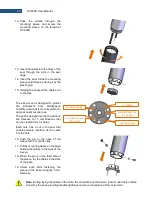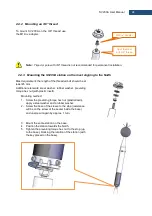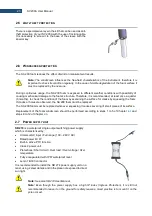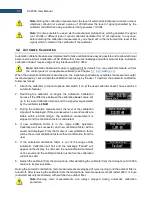
33
SV 200A User Manual
Note: During the calibration measurement, the level of external disturbances (acoustic noise or
vibrations) should not exceed a value of 20 dB below the level of signal generated by the
calibrator (94 dB when using a calibrator that generates 114 dB).
Note: It is also possible to use an electro-mechanical pistonphone, which generates the signal
(ca 124 dB) or different type of sound calibrator
dedicated for ½” microphones. In any case,
before starting the calibration measurement, you should set in the instrument the level of the
signal, which is stated in the certificate of the calibrator.
4.2 A
UTOMATIC
C
ALIBRATION
Automatic calibration feature was implemented to make calibration as easy as possible and to allow technical
personnel to perform a calibration of SV 200A with minimum knowledge and with minimum steps. Automatic
calibration
doesn’t require usage of any interface with SV 200A.
Note: Automatic Calibration feature is switched off by default. You can switch this feature on from
the control panel or via applicable software (see Chapter
When the automatic calibration is switched on, the instrument periodically compares the measured Leq(C)
level averaged by 1 second with the calibration level set up by the user. To perform the automatic calibration,
follow next steps:
1.
Attach the calibrator to the microphone and switch it on (if the used calibrator doesn’t have switch-on
automatic feature).
2. Switching the calibrator on begins the Automatic Calibration
process if the difference between the calibration
Level
value set
up in the Auto Calibration screen and the signal level generated
by the calibrator is
±5dB
.
3. During the calibration measurement, the level of the calibration
signal will be displayed. If three consecutive 1-second results are
stable within ±0.1dB margin, the calibration measurement is
stopped, and the calibration factor is calculated.
4.
If new calibration factor is in the range ±3dB, Automatic
Calibration will be successful, and new calibration factor will be
saved and displayed. From that moment, new calibration factor
will be the current calibration factor without confirmation from the
user.
5. If the calculated calibration factor is out of the r
ange ±3dB,
Automatic Calibration will fail and the message “Failed!” will
appear on the display. In such case the new calibration factor will
not be saved and the calibration factor just before the calibration
will still be valid.
6. Detach the calibrator from the microphone. After detaching the calibrator from the microphone SV 200A
returns to its previous state.
During the automatic calibration, main measurements are stopped (if were running) and the outdoor filter is
turned off. After removing the calibrator from the microphone, main measurements will restart after 1 minute
(auto-start security mechanism) with switched on outdoor filter.
Note: Running main measurements are always stopped during automatic calibration
procedure.






























